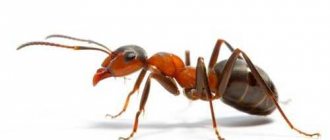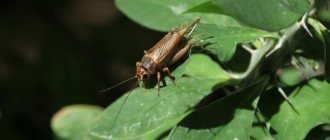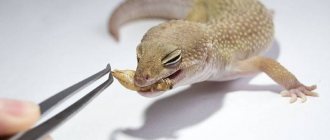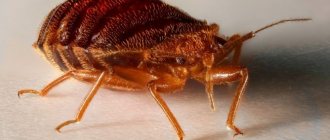- Wild animals
- >>
- Insects
A curious little insect, which, on the one hand, can be unpleasant to the human eye, but on the other hand, delight our ears with its melodic sound. When we walk in a park or forest clearing in warm and dry summer weather, we hear hundreds of unusual “bugs” making sounds with different timbres and frequency, proudly called crickets .
Origin of the species and description
Photo: Cricket
In our nature, there are several species of crickets from the family of “true crickets”, the Latin name of which is Gryllidae:
- Far Eastern stem cricket (Oecanthus longicaudus) - they can be found in Japan, China and the Russian Far East. The second name of the insect is “eastern trumpeter”.
- The field cricket (Gryllus campestris) is a species of orthoptera cricket. They are found more often in the countries of Asia Minor and Western Asia, Southern and Central Europe, and in African countries. They mainly prefer sunny meadows and fields, open places under the sun, light pine forests, and any open areas under the sun.
- House cricket (Acheta domesticus) - like the field cricket, belongs to the species of orthoptera crickets. This insect settles during the cold period in human dwellings, in any warm rooms, heated industrial buildings, basements, etc. With the onset of warm spring and until the warmest autumn, they leave the premises and other outbuildings into nature. The second name is house cricket.
There are also ant crickets, otherwise they are called “common ant-loving”. Belongs to the order of Orthoptera insects and a species of small ant crickets. They are also called ant-loving crickets. Small and wingless insects. They are considered the smallest of all cricket insects. The closest relatives of crickets are grasshoppers and locusts.
Growing insects as a business, report from the farm
In Asia, insects have long been eaten. This is not news, but still unusual for a European. When Russian tourists come to China or Thailand and see spots with fried insects on the market, the typical reaction is to take a photo or quickly move away. The bravest ones try it mainly for the sake of an unusual photograph for social networks. But since the locals eat them, it means they are grown somewhere. IQ Review visited a farm where crickets and butterfly pupae are raised for sale. Our report today is about the insect business.
This insect farm is located in Thailand in the Pattaya suburb of Huai Yai. It supplies products to local markets, where Thais and tourists from all over the world buy them.
Apparently, the beetle business is going well - land here is expensive. Of course, this is not the first line from the sea, but only 5 km. For comparison, a good home in this area costs $120,000. The owners' house is simple, combined with a farm. However, they have another piece of land at some distance, intended for breeding insects.
Mostly crickets are grown here for food. They are the ones rummaging around in the box in the photo. Here's the view from above.
Egg cells are used specifically. Insects gnaw holes in them and lay eggs, which fall to the next layer - this makes it easier to separate generations. They are fed pumpkin.
Here's a short video of what the farm looks like from the inside.
When the insects lay eggs, the larvae are separated directly from the cells and transplanted into separate boxes.
Insects grow quickly, a lot of them grow. This photo shows only a small part of what falls out of the cells when you shake them.
You may ask why insects don't try to escape from open boxes. Well, they don’t know that their original box is part of the business of growing them for food! They feel at home. All the conditions - warmth, as much light as needed and food - what more could a cricket want?
This video is not for the faint of heart. The box has been shaken a little, and the beetle catch is being prepared for sale.
Here is a bucket full of insects.
Next, the live goods are packaged and weighed. Here's how it happens.
The bugs scurry around in the bag... not for long. Like any living beings, without oxygen they suffocate. But it's for their own good. It's much better than dying in boiling oil.
In addition to crickets, butterfly pupae are sold here. They look like healthy larvae. We were not allowed to see the growing process. The goods were sold already dead.
SUMMARY
Raising insects costs next to nothing. Once you invest money in space and mesh boxes, you spend only on electricity and vegetables. The same customer base buys regularly. The product remains fresh for 2-3 days. There are several points selling insects in Pattaya. There are no millions here, but the demand is stable.
Additionally, you can raise chickens. It is not profitable to buy insects to feed poultry and livestock. A kilo of beetles costs $3, and a kilo of rice costs less than $1. But for homestead farming it is quite suitable. Visually, the owners of this business live well: they have iPhones and an indispensable attribute of the Thai middle class - a new pickup truck. Even 2 pickups.
We went to the farm with the owner of a small shop selling fried insects. After the purchase we were given a business card - come again!
Ananya bought a nearby market stall with bugs. The family business of the previous owners was going well, but not well enough to support all five family members. As a result, they quarreled and decided to sell their point.
About 3 kg of insects are sold per day - fried crickets and butterfly pupae. Their purchase price is $10. A plate of approximately 80 grams costs $0.6. The only expenses for cooking are oil, sauce and gas for frying. The outlet sells not only fried beetles, so it is not possible to calculate exact figures on profit and profitability.
The larvae are rich in protein. They taste like seeds. Bon appetit!
Appearance and features
Photo: Cricket insect
All crickets are quite small in size, but still differ in their appearance depending on which group the insect belongs to.
House cricket, up to approximately 24 mm in size. There are eyes on both sides. “The antennae on the head are longer than their body, which serve the function of touch.” The body is covered with a special substance called chitin. It helps the insect protect itself from harmful environmental factors and also prevents water loss.
Video: Cricket
The color is gray-yellow, and the body itself has streaks of brown shades. They have wings that help them move at high speed. When folded, the wings protrude beyond the body itself and resemble a long tail. House crickets do not use their wings.
They have three pairs of limbs, the back pair is longer, so thanks to them the cricket can move quickly and over long distances. The front pairs of paws act as hearing organs. The back part of the body is called the “ovipositor”. Females and males have them, but they differ in size. In females, the ovipositor is longer - approximately from 1 to 1.4 cm, in males it is 3 - 5 mm less.
The field cricket differs from the “domestic” cricket in its impressive size. The size of an adult is up to 2.5 cm. The body is black with brown shades, and covered with gloss. The head is oval with eyes and antennae. Otherwise, the “field bug” is similar to the brownie cricket.
The eastern trumpeter grows up to 1.3 cm. Compared to its counterparts, it is much smaller. The stem cricket received its name due to the fact that it lays clutches of eggs in the plant stems themselves. The second name, “eastern trumpeter,” was given because of its origin (the Far East).
In color it is distinguished by its brown flowers, with shades of green. Also long antennae, 3 pairs of legs, the hind ones of which are the most powerful, wings and elytra are transparent. The elongated body somewhat resembles a grasshopper. Ant crickets are the smallest, up to 5 mm. They do not have wings, and their appearance resembles domestic cockroaches.
Cricket fights
The tendency of crickets to clash is successfully exploited by Asian peoples who stage exciting fights between these insects. To warm up, it is enough to place a female between the six-legged opponents, for which a serious fight breaks out at the same second. The winner of the championship gets a comfortable cage, a rich menu and a harem of the most attractive females. The offspring of such a fighter will be valued at a huge amount of money.
The owners raise the morale of the losing pets by throwing them into the air, which forces the insect to spread its wings and fly. The cricket will not fly far, but the cheerfulness in its depressed mood from losing will significantly increase. According to research, during flight the insect produces octopamine, the so-called fearlessness hormone, which gives the male the ability to fight further.
Where does the cricket live?
Photo: Cricket in the grass
The habitat of “house” crickets is in areas with a warm climate in the summer months: green fields, meadows, open forest glades, pine groves under the sun. They dig a hole for themselves with their jaws, in which they subsequently take refuge during periods of bad weather or danger. When they leave their shelters, carefully covering it with grass, they go in search of food.
With the onset of cold weather, the house cricket seeks shelter in house outbuildings, and in any dwellings where there is warmth. They do not live in apartments, not counting the first floors of old houses. Field crickets live only in warm regions, in meadows, fields and forests. They dig their burrows in loose and oxygenated soil, 15 to 25 cm deep. These burrows are considered their shelter. During periods of cold weather, it overwinters as a larva and imago (in the adult insect stage).
Females can leave their burrows in search of a partner, leaving him covered with a bunch of grass, but males will not abandon their shelter. Rather, on the contrary, they protect him from their relatives and engage in battle if necessary. It is not uncommon for field crickets to die for their “house.” For most of its existence, the field cricket lives on the soil surface.
The common stem cricket lives in the territories of the Far East, steppe Russia, southern Siberia, the Caucasus and Kazakhstan. Prefers to settle in plant stems, bushes, and foothills. Waits out bad weather under leaves on the ground.
Ant crickets live in the warm countries of America. They live near ant nests. And they wait out the cold periods from October to March in the anthills themselves in the adult and larval stages. This species can be found in Western and Eastern Europe, they were found in Russia and Ukraine, there is information about finds in Italy and Romania.
Field grasshoppers
They have a laterally compressed body with a fusiform and slightly compressed abdomen at the top. Field grasshoppers are also lobed and large-headed, often lack simple eyes and have tightly compressed lips. The jaws of insects of the group are well developed.
Green grasshopper
Cannot be larger than 7 centimeters in length. The insect is painted green. The color on the wings is especially rich. There are 2 pairs of them. This is a feature of all grasshoppers. They use the first narrow pair of wings to protect the body when at rest and when jumping. The upper wings are wide and are used for flight.
On the wings of a green grasshopper there may be brown along the edge. Large eyes stand out on the insect's muzzle. They are faceted, that is, they are held on the head by a ring of cuticle - a tough but flexible tissue.
There are subspecies of green grasshoppers
. They all hide in the crown of bushes and trees. Therefore, insects do not jump out from under people’s feet. Accordingly, meetings with representatives of the group are rare.
song grasshopper
This is a mini copy of a green grasshopper. The songbird does not grow more than 3.5 centimeters. Another 3 may be on the ovipositor.
The wings of the singing grasshopper end level with the abdomen. Representatives of the green species have wings that protrude significantly.
Gray grasshopper
Grows up to 4 centimeters in length. Appearance of a grasshopper
matches the name. The abundance of brown spots on a green background makes the insect gray when viewed from a distance. Gray grasshoppers are easy to see. They live in field and steppe grasses, easily tolerating the heat.
Due to their prevalence and large size, gray grasshoppers are confused with locusts, which belong to the short antennae suborder. In its name lies the difference between insects.
The antennae of the gray grasshopper are often longer than its body. Locusts have short whiskers. The mechanism of chirping also differs. makes sounds by rubbing its paws together. The grasshopper arches its elytra.
Gray one of the most common types of grasshoppers
Long-nosed grasshopper
Represents the fauna of Europe. The length of the insect does not exceed 6.3 centimeters. The color of the grasshopper is brown-green.
The long-nosed insect is named because of the elongated front part of the muzzle. The grasshopper appears to be equipped with a proboscis.
Grasshopper-leaf
In Latin it is called Elimaea Poaefolia. Among field grasshoppers it has the longest body. It is narrow and green. This allows you to blend in with the blades of grass on which the grasshopper sits.
The leaf grasshopper lives in the Malay Archipelago.
Giant weta
Endemic species, found only in New Zealand. The weta weighs about 70 grams, that is, 2 times more than a sparrow. The length of a well-fed grasshopper reaches 15 centimeters. The rest of the appearance is unremarkable. The insect is colored in beige-brown tones.
The legs of the giant weta are of medium length, the eyes are of medium size, and the mustache is of mediocre length in comparison with the size of the body.
The gigantism of New Zealand grasshoppers is due to the absence of small mammals on the islands. For lack of enemies, the Wets almost reached their size. However, in the 20th century, mammals were introduced to the fields of Zealand. Because of this, the number of giant grasshoppers is declining.
Grasshopper giant weta
What does a cricket eat?
Photo: Insect cricket
The cricket's diet is very varied. In their nature, they all feed on plant foods: roots and leaves of plants, fresh shoots of grass, leaves of shrubs. They prefer young seedlings, especially adult ones. Field crickets are omnivores, and since they need protein in addition to plant foods, they also feed on small ground corpses of invertebrate insects.
House crickets also eat leftover food left by humans. But greater preference is given to liquid food at home. Small invertebrates also eat soft and corpse tissues of insects. “Domestic insects have such a concept as cannibalism. Adults can eat young animals and larvae that have not yet reached sexual maturity.”
Specially grown crickets are fed plant foods that are always rich in proteins. The diet contains: leftover fruits and vegetables, bread crumbs and other cereals, tops and leaves from the garden, as well as fish and egg meal. But most importantly, they need liquid, which is best given in the form of a sponge soaked in water. Such crickets are specially raised at the Moscow Zoo to feed their charges.
This is a harmless insect; they do not bite and do not show aggression towards the surrounding world and humans. All their hostility can only manifest themselves towards their rival who has entered his protected territory. Therefore, you should not be afraid of him.
But there are times when, due to an overpopulation of crickets in an area, the harvest may be lost. This is the exception rather than the rule, but cases have occurred. And under certain weather conditions, a cricket can reproduce very quickly and “a lot.” Then special tools will come in handy as assistants to help get rid of uninvited guests.
When they chirp
In most cases, you can only hear a cricket chirping at night. That's when the musicians come out of their holes. Although in country fields you can enjoy the trill at any time of the day. During mating games, insects can play music both day and night. Silencing an Orthoptera is very easy. He stops singing as soon as he senses danger. Therefore, at the slightest approach to him, the male hides in a hole.
The simplicity of the grasshopper's acoustic organ prevents them from chirping at night. At this time, dew falls in the grass and the wet organ is not able to emit trills. The sound of the green insect can only be heard during the daytime.
In Japan, little musicians are especially respected. They are bred specifically to be able to listen to melodious ringing at any time.
The working rhythm puts a lot of stress on the nervous system. And a person wants to relax, forget about work. It is especially difficult to work in the city in the summer, when vacation will only be in winter.
To keep your nervous system healthy and not lose performance, you just need to go out of town or climb into a remote place in a city park. And as soon as you spend a little time in silence, the music of nature begins to flow - the chirping of grasshoppers.
Features of character and lifestyle
Photo: Cricket
The most striking feature that a cricket has, and why people sometimes breed them at home, is its melodic sounds. They produce unique, special and melodious signals. Moreover, such “melodies” are produced exclusively by sexually mature males. There are three types of signals. Each sound has its own meaning. Some signals encourage the female to mate, while others scare away potential female suitors. And still others emit signals when courting a partner in order to attract her.
How do crickets make sounds? On the right wing of the “bug” there are special chirping cords, which in turn rub against the left wing. This is how the chirping sound of a cricket comes about. And the raised wings serve as a sound resonator. Their wings create more than 4,000 vibrations per second. Thus, the signals are very clearly audible to humans. Crickets chirp all summer long, and you can clearly hear it while outdoors.
“In the old days, it was believed that if a “screaming” cricket lives in a house, it brings good luck to the owner and protects him from evil and disease. For the pregnant girls living in the house, this meant an easy birth. And we shouldn’t have gotten rid of them.” Today everything is different, not many people like such “vocalists”, some simply disdain insects, and for others such singing interferes with sleep.
This insect loves warmth very much; without it, their process of reproduction and development slows down, and they become inactive. And if the temperature reaches sub-zero temperatures, the insect simply goes into hibernation.
By the way, in some Asian countries, crickets are eaten and are considered a delicacy. Many visiting tourists are offered to taste this insect during excursions to markets.
Crickets have a special way of life - one male has a certain part of the territory that he controls. Can attract many females, whom he will consider only as his own. Something like a harem. But God forbid another male gets into his territory - a fight will break out in which only one individual will survive. And the male who wins can dine on his rival.
The Chinese, taking advantage of their lifestyle of competition between males, organize field cricket fights. The winning cricket in the duel receives a “reward”.
Adult grasshopper
By mid-summer, the larva molts for the last time and becomes an elegant winged insect. In hot weather, grasshoppers mostly sit motionless, with their front legs extended. This is very reminiscent of the posture of their close relative, the praying mantis. Like the praying mantis, the grasshopper has grasping spines on the inner surface of its front legs, albeit small ones. If a hunter comes across a careless filly, the blacksmith quickly deals with it with a bite to the back of the head, eats it, leaving only the head and wings, and freezes again.
Males sometimes emit separate trills to attract females, but the main courtship takes place in the second half of the night. The song produced by a green grasshopper resembles striking metal, sounding very quietly, as if in the distance. This is why the insect got its name.
At dawn, the activity of grasshoppers increases. Diurnal insects, as a rule, are poorly oriented in the dark. The grasshopper is helped by long mustaches and sensitive hearing organs located on the front legs. Some fillies are twice the size of a farrier, but a powerful bite to the back of the head immobilizes any of them. Even cicadas that fly well cannot escape. In areas with sandy soil there is even more nourishing food - young beetles. The mass emergence of these beetles occurs at night, and many of them, upon reaching the surface, immediately become prey.
The tendency towards predation is mainly shown by females, and males have a sweet tooth. Fruits that have fallen to the ground are a real delicacy for them; the strongest individual does not allow competitors to approach the food, driving them away with blows of its hind legs. If you are unlucky in the hunt, the grasshopper is content with vegetation. Thus, this insect can be called an omnivore.
In a number of Asian countries, the grasshopper is considered a popular pet, along with the cricket. Pleasant sounds are produced by males of the species Tettigonia cantans (singing grasshopper) and some others. Chinese breeders have even developed several breeds that sing differently than their wild ancestors. The price of a particularly “euphonious” grasshopper reaches $20.
Middle zone grasshoppers can also be kept at home. Their food is lettuce leaves, unripe ears of wild cereals, berries, pieces of apples, pears and other fruits. Beetles, small locusts and other living creatures will be eaten at night, but if the grasshoppers are hungry, the hunt will take place at any time of the day. When the time comes for females to lay eggs, it is better to lay them one at a time, otherwise the struggle for territory will lead to fights and cannibalism. And the males will live peacefully with each other and chirp until the fall.
Social structure and reproduction
Photo: Field cricket
All insects go through three stages in their life cycle: egg, larva and adult (otherwise known as imago). But the process of reproduction of crickets in each species differs in terms of development, number of stages and life expectancy:
Field crickets sing “serenades” at the entrance of their burrows, calling for females to mate. After the mating process, females lay up to 600 eggs in the soil. Larvae appear after 2.5 - 4 weeks. This occurs at the very end of spring or beginning of summer. After the larvae hatch from the eggs, they immediately moult and become like wingless little bugs that can only crawl on the ground.
They grow very quickly and can molt up to 8 times throughout the summer. As soon as the cold weather sets in, they hide in their burrows dug with their jaws. In houses, after 1 - 2 molts, they turn into an adult (imago). And as soon as they feel the warmth coming, they crawl out as adults and again prepare to reproduce. After laying eggs, the female dies by the end of summer. Life period – up to 1.5 years.
The common cricket lays its eggs in moist cracks in the soil. One female can lay up to 180 eggs per season, but at high temperatures, from +28 and above, she can lay 2–3 times more. After a week and up to 3 months (depending on weather conditions - the warmer it is, the faster the emergence occurs), the nymphs hatch, also wingless. They go through 11 stages of development to adulthood. The duration of the “domestic” imago is up to 90 days.
The principle of mating and laying eggs of the stem cricket is similar to the previously described methods. And life expectancy is approximately 3 – 4 months. Much depends on climatic conditions and the habitat of this species.
The cycle of laying eggs until the full development of an adult ant cricket is 2 years. The longest of all types. And the process itself consists of 5 stages, which takes place in anthills. Life expectancy is up to six months. “This type of cricket is not capable of singing, so mating takes place without courtship and a long search for “suitors.”
Foreign superstitions
There are many myths about insects that are relevant among representatives of different nations. The Chinese are confident that they help prolong life. Therefore, they believe that they should be started at home.
Acheta domesticus
The Indians used crickets to prepare a special tincture that helped a person become more resilient, faster, and physically stronger.
The Japanese believed that musical insects could be tamed and settled them in their homes. It was believed that sitting next to the house, crickets sing for their owners, thereby lulling them to sleep. But if someone unfamiliar approaches the house, the insects immediately fall silent, warning that a stranger is coming to the house.
In Brazil, they believe that the singing of an insect attracts death.
There are many superstitions associated with crickets - they can warn of both bad and good events, and attract happiness and good luck into the house. Therefore, do not rush to drive away such a little messenger, even if he disturbs sleep with his night trills.
Natural enemies of crickets
Photo: Cricket
Crickets don't have many enemies. Partly this is a person, since with a large overpopulation of insects, he will begin to fight them. Since no one wants to lose their harvest, people begin to fight crickets using chemicals. This does not happen in our middle zone, since in order for a large number of them to breed, a tropical climate is needed, which we do not have.
Man uses cricket as bait to catch rare fish species. But in some Asian countries they are eaten. In other countries, the insect is used as food for animals - reptiles that live in the house as pets. Since crickets are rich in proteins and proteins, they are considered a valuable food product.
Interesting fact: in 2022, one newspaper talked about an American company in Texas, which was the very first to produce fried snacks consisting of crickets in five flavors: sea salt, barbecue, sour cream and onion, etc. The snacks were then positioned as protein and protein foods .
How to get rid of house "guests"?
The presence of these insects at home is a bad sign. They create a lot of noise and simply keep you awake at night. They are masters of camouflage, which also creates additional problems when searching for them. To avoid “settlement”, follow these tips:
- Close all possible paths. They usually enter a home through a cracked window, a crack in the wall, or a hole in the flooring. Check the house and make sure it is airtight.
- Don't litter. Remove crumbs and close the trash can tightly. Eliminating the food source eliminates the cricket problem in general, as does cockroaches.
- Clean up the house. They love piles of paper and other miscellaneous items that might be considered trash.
- Treat the area near the house with pesticides. If the population in the house has reached a critical level, it will not be possible to get rid of them manually. To do this you will have to purchase an insecticide. Treat areas around your doors and windows with it. You can also walk around the perimeter of the foundation. Be sure to check the instructions and directions for use if you have small children or pets.
Are they eaten?
In southern Asia, including Cambodia, Laos, Thailand, Vietnam, insects are eaten as a snack made by deep-frying soaked and cleaned insects.
Cricket flour is used as an additive in consumer products such as pasta, bread, crackers, and cookies. Flour is used in protein bars, pet food, livestock, and industrial purposes.
They are bred as food for zoo carnivores, laboratory animals, and domestic animals.
They have a high protein and calcium content. Every 100 grams of insects you eat will provide 13 grams of protein and 76 milligrams of calcium.
References:
- Gorokhov, A.V. Life forms of crickets (Orthoptera, Grylloidea) of Central Asia / Gorokhov A.V. // Entomol. review – 1979.- T.58, No. 3.- P.506-521.
- Gorokhov, A.V. On the morphological criteria of the genus in crickets (Orthoptera, Grylloidea) / Gorokhov A.V. // General entomol. – L.: Science – 1986. – T. 68. – P. 17-19.
- Zhantiev, R.D. Bioacoustics of insects / R.D. Zhantiev. – M.: Publishing house Mosk. University, 1981. – 256 p.
- Zhuravlev, Yu.D. Insect cultures used for feeding amphibians and reptiles in the terrarium of the Almaty Zoo / Zhuravlev Yu.D., Pugacheva N.A. // Scientific research in zoological parks. – M., 1994. – Issue. 4. – pp. 110-111.
- Knyazev, A.N. Developmental cycle of the cricket Gryllus bimaculatus Deg. (Orthoptera, Gryllidae) under laboratory conditions / Knyazev A.N. // Entomol. review – 1985. –T.64, Issue 1. – P. 58-74.
- Yasyukevich, V.V. Cultivation of crickets for feeding exotic animals / Yasyukevich V.V., Rivkin L.E. .// Scientific materials - practical conf. Animal culture and biological resources. – M.: Scientific T. ed. KMK., 2005. – pp. 146-148.
- Alexander RD The evolution of genitalia and mating behavior in crickets (Gryllidae) and other Orthoptera / Alexander RD, Otte D. // Misc. Pabl. Mus. Zool. Univ. Michigan. – 1967. – Vol. 133. – R. 1-62.
- McFarlane JE Studies on group effects in crickets / McFarlane JE // Can. J Zool. – 1984. – Vol. 44. – P. 1017-1021.
- Wineriter SA Group and individual rearing of field crickets (Orthoptera: Gryllidae) / Wineriter SA, Walker TJ // Entomol. News. – 1988. –Vol. 99, No. 1. – P. 53-62.
- Wyniger R. Insektenzucht / R. Wyniger. – Stuttgart: E. Ulmer Verlag, 1974. – 368 rub.
Habitat
They live in all parts of the world, with the exception of cold regions, latitudes above 55° north and south latitudes. The greatest diversity is found in tropical locations such as Malaysia, where 88 species can be heard chirping near Kuala Lumpur.
Members of several subfamilies live on the tops of trees, bushes, and among grasses. They are found on the ground, in caves, some are underground, digging shallow or deep holes. Others live in rotting wood, on the beach, and can run and jump on the surface of the water.











